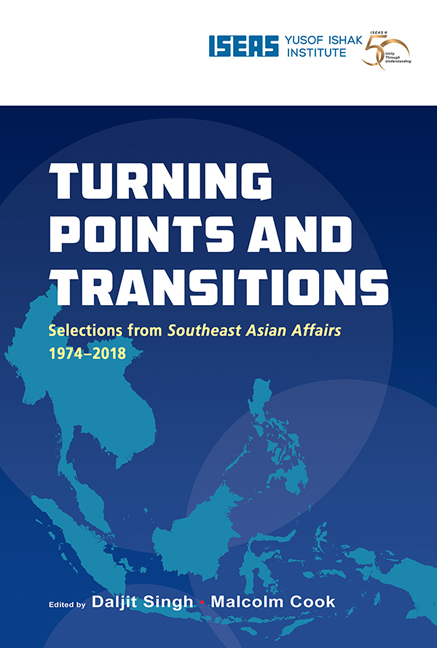Book contents
- Frontmatter
- Contents
- Message from the Director
- Foreword
- Foreword
- Introduction
- THE REGION
- BRUNEI
- CAMBODIA
- INDONESIA
- LAOS
- MALAYSIA
- MYANMAR
- THE PHILIPPINES
- SINGAPORE
- THAILAND
- VIETNAM
- Vietnam in Perspective (1975)
- Year One of Postcolonial Vietnam (1977)
- Vietnam, ASEAN and the Indochina Refugee Crisis (1980)
- Vietnam and ASEAN: A First Anniversary Assessment (1997)
Vietnam and ASEAN: A First Anniversary Assessment (1997)
from VIETNAM
Published online by Cambridge University Press: 29 May 2019
- Frontmatter
- Contents
- Message from the Director
- Foreword
- Foreword
- Introduction
- THE REGION
- BRUNEI
- CAMBODIA
- INDONESIA
- LAOS
- MALAYSIA
- MYANMAR
- THE PHILIPPINES
- SINGAPORE
- THAILAND
- VIETNAM
- Vietnam in Perspective (1975)
- Year One of Postcolonial Vietnam (1977)
- Vietnam, ASEAN and the Indochina Refugee Crisis (1980)
- Vietnam and ASEAN: A First Anniversary Assessment (1997)
Summary
Paradigm Lost — Changing Foreign Policy Models
During the mid- to late-1980s, a major transformation took place in how Vietnam's policy élite conceptualized foreign policy. The roots of this transformation are twofold. They lie in domestic circumstances arising from the socio-economic crisis which confronted Vietnam at that time. And secondly, they lie in external influences arising from the “new political thinking” fashionable in Gorbachev's Soviet Union. Vietnam turned from a foreign policy model heavily structured by ideological considerations to a foreign policy model which placed greater emphasis on national interest, balance of power and realpolitik. Vietnamese analysts now tend to emphasize global economic forces and the impact of the revolution in science and technology over military aspects of power when weighing the global balance. The old and new foreign policy models are not mutually exclusive. Ideology and national interest are not dichotomous terms; they can and do overlap and co-exist.
The influence of ideology on Vietnam's foreign policy prior to the mid- to late- 1980s may be illustrated as follows. From the inception of the Democratic Republic of Vietnam as an established state in Southeast Asia in 1954, its élite accepted the “two camp” thesis that the world was divided between the forces of socialism and imperialism. In the late 1960s Vietnam adopted a framework known as the “three revolutionary currents”. According to this model, global order was determined by three trends (or revolutionary currents): the strength of the socialist camp headed by the Soviet Union; the strength of the workers’ movement in advanced industrial countries; and by the strength of the forces of national liberation in the Third World. In practical terms, Vietnam allied itself with the Soviet Union as the “cornerstone” of its foreign policy. Hanoi's leaders also viewed Indochina as a strategic entity and sought to develop an integrated alliance system with Laos and Cambodia. Vietnam's 1978 invasion of Cambodia and 25-year treaty of friendship and co-operation with the Soviet Union were logical end products of this orientation. They resulted in a decadelong polarization of regional relations. Vietnam was left isolated and dependent on the Soviet Union and Eastern Europe for economic support.
- Type
- Chapter
- Information
- Turning Points and TransitionsSelections from Southeast Asian Affairs 1974-2018, pp. 762 - 771Publisher: ISEAS–Yusof Ishak InstitutePrint publication year: 2018



